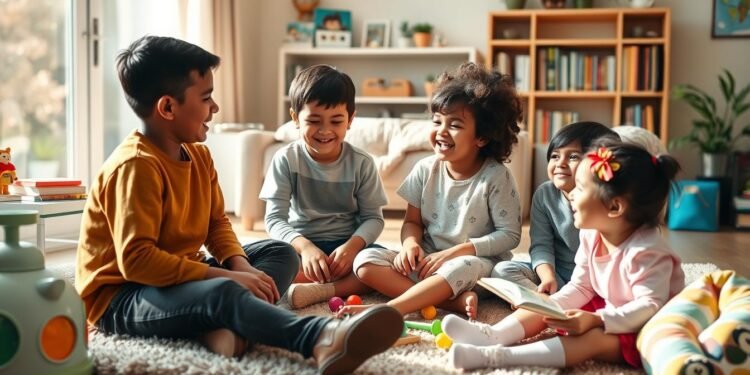Did you know that teaching your child a second language can reshape their brain for the better? Studies from Northwestern University reveal that bilingual children develop enhanced grey and white matter, leading to improved cognitive skills. This isn’t just about learning words—it’s about unlocking a world of benefits for your child’s development.
More families are embracing bilingual parenting to preserve their culture and give their children a head start in life. From practical home routines to cultural immersion events like Harmony Week in Australia, there are countless ways to make language learning a natural part of daily life. But where do you start?
This article explores simple yet effective strategies, such as the OPOL (One Parent, One Language) model and community engagement, to help your child thrive in a multilingual environment. Let’s dive into how you can create a language-rich home that fosters growth and connection.
Key Takeaways
- Bilingual parenting enhances cognitive and social skills in children.
- Home routines are key to making language learning a daily habit.
- Cultural events like Harmony Week can deepen language immersion.
- Research shows bilingualism improves brain structure and function.
- Strategies like the OPOL model simplify bilingual parenting.
Why Raising Bilingual Kids is Beneficial
Learning multiple languages can significantly boost a child’s brain development and cognitive abilities. Studies show that bilingualism increases grey matter volume in the prefrontal cortex, the brain’s decision-making center. This change enhances mental flexibility and problem-solving skills.
Dr. Chung-Fat-Yim compares this process to expanding a subway station. Just as more tunnels allow trains to move faster, a stronger neural network improves communication between brain regions. This leads to 27% faster neural processing, according to Northwestern University research.
Bilingual children also excel in task-switching, outperforming monolingual peers by 38% in category-switching tasks. This skill is like multitasking for the brain, making it easier to adapt to new challenges. Additionally, bilingualism builds a cognitive reserve that can delay Alzheimer’s symptoms by up to five years.
Cognitive Advantages of Bilingualism
Speaking multiple languages keeps the brain active, much like a constant workout. This mental exercise strengthens neural pathways, improving memory and focus. Bilingual individuals often show better attention control and problem-solving abilities.
Research also highlights the long-term cognitive benefits. A 2020 meta-analysis found that bilingualism can delay dementia by maintaining brain health. This makes language learning a powerful tool for lifelong mental wellness.
Cultural and Social Benefits
Beyond cognitive gains, bilingualism fosters cultural identity and strengthens social bonds. Families who maintain their heritage language pass down traditions and values across generations. This creates a sense of belonging and pride in one’s roots.
In school environments, bilingual children often show greater empathy and cross-cultural understanding. They can connect with peers from diverse backgrounds, building stronger relationships. This skill is invaluable in today’s globalized world.
Effective Strategies for Raising Bilingual Kids
Building a multilingual home doesn’t have to be overwhelming—it can be fun and rewarding. With the right approach, you can create a language-rich environment that makes learning feel natural. Consistency is key, and small changes in your daily life can have a big impact.
Creating a Language-Rich Environment at Home
Start by designating specific areas for each language. For example, the kitchen could be a space to use language like Spanish, while the living room is reserved for English. This helps children associate different languages with specific contexts.
Label household items with dual-language tags, such as “refrigerator/nevera.” This simple trick reinforces vocabulary in both languages. Additionally, incorporate books, music, and games in the target language to make learning engaging.
Incorporating Language into Daily Routines
Morning rituals are a great way to integrate language learning. Try discussing the weather in the target language during breakfast. This not only builds vocabulary but also sets a positive tone for the day.
Bedtime is another opportunity to use language. Share stories from heritage language books, which can be borrowed from local libraries. Cooking together is also a fun way to teach meal prep vocabulary while spending quality time as a family.
Studies show that children need 20-30% of their waking hours in the minority language to achieve fluency. By weaving language into daily routines, you can meet this goal effortlessly.
Models for Raising Bilingual Children
Different families find success with various language models tailored to their needs. These approaches provide structure and consistency, making it easier to nurture multilingualism at home. Whether you’re focusing on a minority language or balancing multiple tongues, there’s a model that fits your lifestyle.
One Parent-One Language Model
The one parent-one language (OPOL) approach assigns each parent a specific language to speak with the child. For example, one parent might use English, while the other speaks Spanish. This method ensures consistent exposure to both languages.
Studies show that OPOL requires at least 30 hours per week per language to be effective. Families like a French-Japanese household in NYC have found success by involving grandparents to reinforce the minority language. To overcome challenges, some families dedicate weekends to one language, creating “language holidays.”
One Environment-One Language Model
Another effective strategy is the one environment-one language model. Here, specific spaces or contexts are tied to a particular language. For instance, a Swedish family in Texas might use Swedish exclusively at home, while English is reserved for school and the community.
This approach helps children associate languages with specific settings, reducing confusion. Tools like the FAMILY-LINK app can track daily language exposure, ensuring a balanced mix. Reminders like “Oops, en français!” can also help address common pitfalls like code-switching.
By choosing the right model, parents can create a language-rich environment that supports their child’s heritage and future success.
Practical Tips for Supporting Bilingual Development
Supporting language development can be both fun and impactful with the right strategies. By integrating play and games and engaging in community activities, you can create a dynamic learning environment that keeps children motivated and excited about their heritage language.
Using Play and Games to Enhance Language Skills
Games are a powerful tool for language learning. Modify classic games like Scrabble to include dual-language dictionaries. This not only builds vocabulary but also makes learning interactive and enjoyable.
Create treasure hunts using GPS geocaching apps, where clues are in the target language. This combines technology with physical activity, making it a memorable experience. Music is another excellent resource—studies show it improves vocabulary retention by 40%.
Engaging in Community Activities
Community involvement is key to reinforcing language skills. Partner with cultural organizations to join language-specific sports leagues or attend cultural activities. These events provide real-world practice and deepen cultural connections.
Organize “language cafes” at local libraries, where native speakers and learners can converse. This fosters a sense of belonging in the local community and encourages consistent practice. Social media also plays a role—92% of bilingual teens maintain their heritage language through platforms like Instagram and TikTok.
By blending play and games with community activities, you can create a well-rounded approach to language development that is both effective and enjoyable.
Conclusion
Embracing multilingualism at home offers long-term advantages for children and families alike. The neurological benefits, cultural continuity, and practical methods make it a rewarding journey. Tools like the Language Parent® app can help track progress and maintain consistent routines.
Take inspiration from a trilingual family successfully maintaining Italian, Spanish, and English. Their story shows how dedication and creativity can foster bilingual development while preserving heritage.
Ready to start? Download our 30-day bilingual family challenge calendar and take the first step today. Remember, 84% of multilingual adults credit their parents for early language exposure—your efforts today can shape their future.
FAQ
What are the cognitive benefits of raising children with two languages?
Children who grow up speaking multiple languages often show improved problem-solving skills, better multitasking abilities, and enhanced creativity. Studies also suggest they may have a stronger memory and greater mental flexibility.
How can I create a language-rich environment at home?
Surround your child with books, music, and media in both languages. Label household items, engage in conversations, and encourage storytelling. Consistency in using each language helps reinforce learning.
What is the One Parent-One Language model?
In this approach, each parent consistently speaks one language to the child. For example, one parent might use English, while the other uses Spanish. This helps the child associate each language with a specific person.
How can play and games support language development?
Playtime offers natural opportunities to practice vocabulary and grammar. Board games, role-playing, and interactive apps can make learning fun while reinforcing language skills in both languages.
Why is it important to engage in community activities for bilingual children?
Participating in cultural events, language classes, or playgroups exposes children to native speakers and real-life language use. It also helps them connect with their heritage and build confidence in speaking.
What are some easy ways to incorporate language into daily routines?
Use meal times, bath time, or bedtime to introduce new words and phrases. Sing songs, read stories, or discuss daily activities in both languages to make learning a natural part of the day.
How does bilingualism benefit cultural and social development?
Speaking multiple languages allows children to connect with diverse cultures, fostering empathy and open-mindedness. It also enhances their ability to communicate with a wider range of people.









